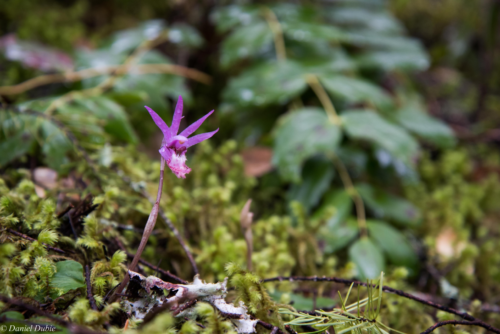
Spring Wildflowers in the Upper Skagit
Spring has come here in the upper Skagit River valley and our April showers have indeed brought May flowers. With the increase of daylight and clear days, the valleys in-between the still snow-covered mountains have turned bright shades of green. The shorelines along the river and its reservoirs are in great contrast against the dark, evergreen hue of the high slopes. While the waking up of the forest rejuvenates even the deepest winter doldrums, there are surprises along the forest floor that bring spring’s energy forth for those willing to go look.

Calypso orchid (Colypso bulbosa) on Sourdough Mountain Trail. Photo by Dan Dubie
Our spring wildflower bloom has begun and is now in full swing. A few weeks ago, as the spring sun started to warm the floors of our valleys and deep forests, the first plant harbingers of spring began to grow. Just as our migrating birds returned to their homes for the summer, our resident perennial and annual wildflowers began their annual strive for life. Quickly after the snow leaves, the first herbaceous flowers to arise are those with energy reserves stored in corms or “bulbs” beneath the ground. These flowers quickly get to work, growing a few leaves and showy flowers that attract the early spring flies and solitary bees. Examples of these are the glacier lily (Erythronium grandiflora), which is known to sprout through snow; the amazingly small calypso orchid (Calypso bulbosa); and the bright white western trillium (Trillium ovatum), which shines like a light on our deep, moist forest floors.

Glacier Lily (Erythronium grandiflorum) on the Fourth of July trail. Photo by Dan Dubie
As the sun continues to shine and ground continues to warm, new flowers turn up by the week. Many of the early spring annuals have begun to bloom or are about to bloom. Of the flowers that I have been finding, three small annuals come to mind; the sky blue wood forget-me-not (Myosotis sylvatica); the even smaller small-flowered blue-eyed Mary (Collinsia parviflora); and the extravagant chickweed monkey flower (Mimulus alsinoides). All these species show that much beauty and character can come from small, delicate plants. Many small flowers like these go unnoticed, except by those who are not afraid of looking in the shadows, in a rock crevice, behind a cascade and even under your feet.

Wood forget-me-not along the shore of Gorge Lake. Photo by Dan Dubie
Other flowers that are busy blooming are those perennials which are partly or completely evergreen. These plants may or may not have some sort of woody stem from which their leaves stay on during the winter or grow from during the spring. Those without woody stems likely keep their leaves but keep them near or on the forest floor, under the winter snow. Early spring examples of non-woody stemmed flowers are the intriguing wild ginger (Asarum caudatum), which is pollinated by ants; the bright yellow evergreen violet (Viola sempervirens); and the hardy grassland saxifrage (Saxifrage integriflia), which grows along rock ledges and outcroppings. The woody stemmed flowers found here provide an important role in these steep mountains, stabilizing the soil structure as they grow low to the ground in thick mats. Examples of these that are blooming now or which will be soon, are the common bearberry or kinnikinnik (Arctosaphylos uva-ursi) and Davidson’s penstemon (Penstemon davidsonii).Theses can often be found in open areas with bare ground and are the evergreen. Both have thick, waxy leaves and beautiful deep, reddish-purple flowers that are pollinated by bees.

Wild Ginger Asarum caudatum at Colonial Creek campground. Photo by Dan Dubie
As the sun continues to shine and the temperatures increase, new wildflowers will continue to appear in every corner of our landscape. Early spring flowers will be followed by late spring and early summer species. As the winter snows retreat from our alpine meadows and ledges, wildflowers will return, bringing life and rejuvenation to a landscape inhospitable much of the year. Spring brings life for all of us, a promise of new beginning and the continuation of life. These wildflowers bring that life to these mountains after a long, dark winter. As our local highway pass opens for the season and activity returns to the North Cascades, I encourage the attentive eye to be on the lookout for the wildflower energy that is rich throughout these incredibly biologically diverse mountains. I wish you pleasant exploring in this beautiful, flower-filled wilderness.
Written by Daniel Dubie, avid birder, naturalist and graduate M.Ed. student at North Cascades Institute and Western Washington University
Title photo of kinnikinnik or bearberry (Arctosaphylos uva-ursi) at the North Cascades Institute Environmental Learning Center. All photos courtesy of Dan Dubie

